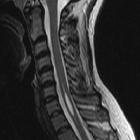Arachnoiditis







Arachnoiditis is a broad term encompassing inflammation of the meninges and subarachnoid space.
Terminology
Arachnoiditis affecting the cauda equina may be referred to as spinal/lumbar adhesive arachnoiditis.
Clinical presentation
Lumbar spine arachnoiditis can result in leg pain, sensory changes, and motor weakness.
In some individuals, CSF flow is impaired, and they may develop syringomyelia which should, therefore, be sought in the cord.
Pathology
Etiology
- infectious
- inflammatory
- intrathecal hemorrhage
- iatrogenic
- intrathecal drugs
- contrast media, e.g. Lipiodol, Pantopaque/Myodil - controversial
- anesthetics
- steroids (accidental intrathecal injection)
- surgery
- intrathecal drugs
Radiographic features
All modalities will demonstrate similar findings although MRI is by far the most sensitive modality.
MRI
Although arachnoiditis can be present throughout the subarachnoid space, it is most easily seen in the lumbar region where the cauda equina usually floats in ample CSF.
As a result of inflammation, the nerve roots become adherent to each other and to the theca. Three resultant morphological patterns have been described on the basis of imaging :
- type I: nerve roots are clumped together and distorted
- type II: nerve roots are adherent to the theca resulting in an empty thecal sac sign
- type III: nerve roots and theca are clumped together into a single soft tissue mass centrally within the spinal canal
Rarely ossification/dystrophic calcification occurs and this is known as arachnoiditis ossificans.
Treatment and prognosis
No treatment is available for adhesive arachnoiditis.
Differential diagnosis
The main differential is leptomeningeal carcinomatosis that can also lead to nerve root clumping although this is not strictly speaking inflammatory in nature and thus not true arachnoiditis. Nevertheless, it is sometimes included under the broader meaning of arachnoiditis and certainly can mimic run-of-the-mill inflammatory arachnoiditis.
- haematogenous spread of systemic tumors (e.g. breast carcinoma or lymphoma)
- direct seeding of the CSF from primary central nervous system tumors
Siehe auch:
- Glioblastoma multiforme
- Ependymom
- Meningitis
- Medulloblastom
- chronisch adhäsive Arachnopathie
- Syringomyelie
- Karzinom des Plexus choroideus
- meninges
- empty sac sign
und weiter:

 Assoziationen und Differentialdiagnosen zu Arachnopathie:
Assoziationen und Differentialdiagnosen zu Arachnopathie:






